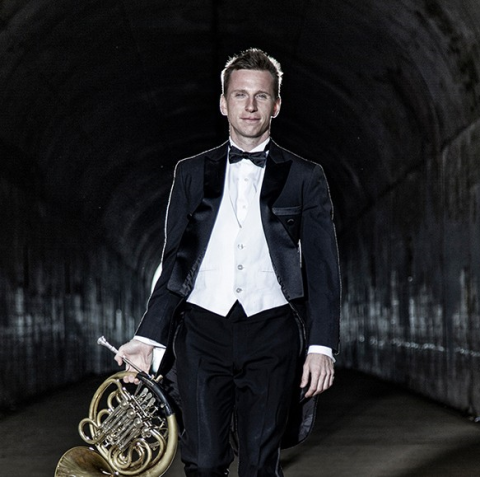Beethoven Symphony No. 2
Principal Horn of the prestigious Berlin Philharmonic and Grand Ledge native, David Cooper, brings Gliere’s romantic Horn Concerto to life for his Lansing Symphony homecoming debut. Ravel's colorful yet melancholy homage to a musical ancestor, and Beethoven’s Second Symphony, a joyous work written during a time of great personal grief, round out this program.
Conductor
Timothy Muffitt
David Cooper
Horn
Le Tombeau de Couperin
Ravel
World War I was just getting started when Maurice Ravel began work on the set of six piano pieces that he eventually called Le Tombeau de Couperin. As an adult Ravel was small and frail, so he was exempt from military service. By the time the war started, he was thirty-nine. Neither size nor age prevented him from signing up as a nurse’s aide. Eventually he became a truck driver and served on the front. A serious bout of dysentery sent him to a military hospital in 1916. A year later, Ravel received his discharge from the army. While he was recuperating from the war, he got back to work on those piano pieces. However, his wartime experiences caused him to change direction. Originally, he intended the work to be a sort of musical memorial—a tombeau—of eighteenth-century French classical music in general, and of the great French composer François Couperin in particular. Now, he dedicated each of the six movements to friends of his who died in the war. One of them was the musicologist Joseph de Marliave whose widow, Margeurite Long, gave the first performance of Le Tombeau in 1919. Shortly after that performance, Ravel chose four of the six movements and reworked them for orchestra.
Le Tombeau de Couperin is something like the old Baroque dance suites: simply a collection of stylized dances. Instead of the typical overture, there is a light and lively prelude. The forlana—a dance with Venetian origins—is even more sprightly in character. The menuet has a gentle, subdued quality. The final movement, a ridaudon, begins and ends with a bang, but has a peaceful and reflective central section. Knowing the sad beginnings of this piece, and the tender dedications to fallen friends, you may find the overall character of Le Tombeau de Couperin surprisingly light and joyful. When criticized for this, Ravel simply replied, “The dead are sad enough, in their eternal silence.”
Program notes by John VarineauHorn Concerto
Gliere
Life was not pleasant or easy for the great Russian composers during Stalin’s reign. If Stalin did not like a composer or his music he would direct one of his lackeys to write a damning review for the press. Eventually there would be a public condemnation issued by the Union of Soviet Composers. Dmitri Shostakovich suffered numerous such condemnations. Even Prokofiev (who wrote Peter and the Wolf) and Aram Khatchurian (whose ballet Gayne is about the joys of working on a collective farm) were eventually condemned for “formalistic distortions and anti-democratic tendencies alien to the Soviet People.” Nevertheless, there were composers that Stalin liked. Reinhold Gliere was one of them.
Gliere was born in Ukraine and studied composition at the St. Petersburg Conservatory with Anton Arensky and Mikhail Ippolitov-Ivanov (both students of Nicholas Rimsky-Korsakov) and Sergey Taneyev (the pianist/ composer who premiered all of Tchaikovsky’s piano concertos). Gliere was part of the nationalist school of composition which focused on developing a distinctly Russian sound by including folk elements in classical music. During the Soviet regime this became known as socialist realism. By 1920, Gliere was appointed professor of music at the Moscow Conservatory and eventually president of the Union of Soviet Composers. The titles of a few of his works may give an indication why Stalin approved of him: “Twenty five years of the Red Army” and “Hitler’s end will come.” His most popular works are his Symphony No. 3 “Il’ya Muromets” (based upon a Russian folk-hero) and his ballet “The Red Poppy” which contains the popular Russian Sailor’s Dance. Compared with other composers of the twentieth century, Gliere’s style is not just conservative, it is reactionary.
Gliere’s Horn Concerto was his last completed orchestral work. It contains all the elements of a standard concerto: The soloist and orchestra each get their turn in the spotlight; lots of beautiful and contrasting themes; a cadenza in the first movement which allows the soloist to make up his own music, and lots of flash and dash. In spite of its emphasis on melody, it makes severe technical demands on the horn player. Listening to the work, you’ll be amazed that it was written in the middle of the twentieth century. It could easily have been written in the latter part of the nineteenth. What is perhaps more amazing is that this conservative Gliere, a latter day Tchaikovsky and loyal company man of the Soviet system, was the first teacher of that revolutionary composer, Sergei Prokofiev.
Program notes by John VarineauSymphony No. 2
Beethoven
By the age of twenty-six, an incessant ringing in his ears already troubled Beethoven. Six years later, in 1802, his doctor suggested a rest, away from the din of the city, in the little town known as Heiligenstadt (now a part of Vienna). While there, he wrote to his brothers Carl and Johann that he wasfinally compelled to face the prospect of a lasting malady (whose cure will take years or, perhaps, be impossible)
"… Ah how could I possibly admit such an infirmity in theone sense which should have been more perfect in me than in others, a sense which I once possessed in highest perfection, a perfection such as few surely in my profession enjoy or have enjoyed."
Such was his despair that he even contemplated suicide. He wrote a short postscript:
“Thus do I take my farewell of thee… O Providence—grant me at least but one day of pure joy—it is so long since real joy echoed in my heart.”
All of this happened at the same time that he wrote the symphony that Hector Berlioz insists is “smiling throughout.” About the only solemn moment in the Beethoven’s Symphony No. 2 is the slow introduction that starts the whole thing off. The second movement, one of the longest slow movements of any Beethoven symphony, is noble and pastoral in character, full of song-like themes. The third movement is a scherzo (Italian for “joke”) and is Beethoven’s first attempt at converting the stately minuet into something more crackling in tempo and humorous in character. The humor continues in the last movement.
Critical reaction to this symphony at its premiere was mixed. People simply thought that it was bizarre and felt that Beethoven was “striving for effect and straining for that which is new and remarkable.” One critic called it “a gross enormity, an immense wounded snake, unwilling to die, but writhing in its last agonies and, though bleeding to death, furiously beats about with its tail in the finale.”
Fortunately, Beethoven never sent the Heiligenstadt Testament to his brothers, and never followed through with his despair. Perhaps more than anything, this symphony is a testament to Beethoven’s ability to transcend his own problems in order to create beauty.
Program notes by John Varineau



